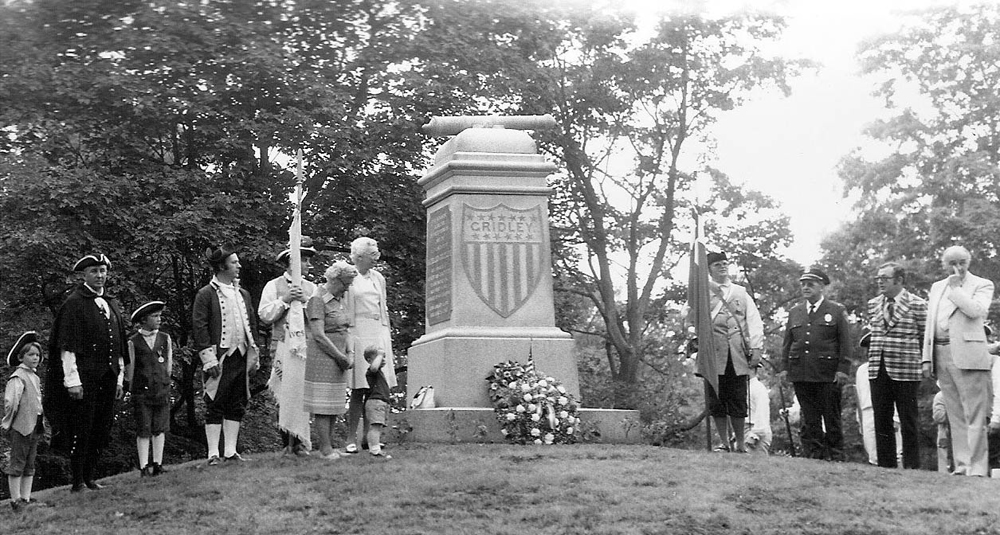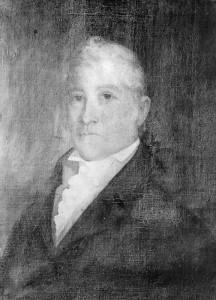True Tales from Canton’s Past: Gridley’s Portrait
By George T. Comeau
Wreath laying in 1976 at Gridley’s Monument in Canton Corner Cemetery (Courtesy of the Canton Historical Society)
David Ingram spent much of his life researching Colonel Richard Gridley. And as far as Canton’s famous citizens go, Gridley stands alongside Paul Revere and Roger Sherman when it comes to American Revolutionary superstars. Gridley played significant roles in King George’s War, the French and Indian War, and the American Revolution, and yet he remains nearly unknown. For Ingram, it was a passion for the unknown Gridley that made him the expert on the man. And yet the one thing that would forever elude Ingram was the likeness of Gridley.
Gridley was born in Boston in 1710, the youngest of 12 children of Richard and Rebecca Gridley. At an early age, he was apprenticed to Boston merchant Theodore Atkinson and soon married Hannah Denning when he was 20 years old. Young and hardy, Gridley had between six and nine children and he remarried after the death of Hannah. Gridley’s second wife, Sarah Blake, is buried here in Canton.
In 1740, the British sent John Henry Bastide to Boston to help design the harbor defense system along the coastline. As chief engineer at Annapolis Royal, Bastide had wide-ranging responsibilities for defenses and fortifications throughout Nova Scotia and New England. At some point early in his work, Gridley became part of Bastide’s inner circle. Only 10 years older than Gridley, Bastide had begun studying military engineering at age 11 and possessed a remarkable background and was a competent designer of battle works and fortifications. In America, it was Bastide who constructed Fort William in Boston Harbor and Gridley had a hand in assisting with the task. It would be safe to say that under Bastide’s direction and guidance, Gridley became an outstanding military mind.
When war broke out with France, Gridley joined the Massachusetts provincial troops and soon took command of a regiment and was named chief bombardier during the siege of Fortress Louisbourg in 1745. Gridley was later a regimental commander at Crown Point and placed in charge of the carpenters during the second siege of Louisbourg. It is no coincidence that Gridley and Paul Revere were well acquainted. In 1756, Revere appears as a second lieutenant under Gridley’s command. And while an ardent supporter of the King of England, when it came time to choose sides Gridley chose the Patriot cause, giving up a lucrative pension and rights to Canada’s Magdalen Islands, which were home to an extensive seal and cod fishery, and lost his lifetime of half-pay as a British officer.
Gridley went on to become a brilliant strategist during the American Revolution. He was wounded in the thigh at Bunker Hill and his personal courage was forged in that very moment. Gridley’s skills as an engineer were highly valued. The Continental Congress appointed him as colonel and chief of artillery in September 1775. General George Washington wished to replace Gridley as the commander of the artillery regiment and did so by asking the Congress to appoint Henry Knox in his place only a few months after Gridley’s appointment. Washington, at 53 years of age, did not get along with the 65-year-old military mind. The public excuse for Washington’s desire to replace Gridley seems to have been grounded in his advanced age and the time it took him to recover from his wound. Gridley, however, remained as the chief engineer of the army and in that role designed the fortifications on Dorchester Heights that eventually required the British to evacuate Boston in March 1776.
Moving to Stoughton in that part which is now Canton in 1772, Gridley owned a forge that had produced howitzers and mortars and his house still stands, near the falls on Washington Street at Shepard’s Pond. Richard Gridley has been cited as one of the most overlooked contributors to the success of the American Revolution. He is remembered by the United States Army Corps of Engineers as its first chief engineer and the father of the Army Corps of Engineers. Gridley died of blood poisoning contracted after cutting rose bushes at his home.

Could this be the only known likeness of Colonel Richard Gridley? (Courtesy of the Canton Historical Society)
It is no surprise that with such an illustrious career, the search for a likeness of Gridley has been sought for over 200 years. In 1902, Albert Folsom of Brookline placed a query in the New England Historical Genealogical Register: “Has any reader knowledge of a portrait or picture of Major General Richard Gridley?” It does not seem that anyone came forward to assist.
In the summer of 1961, the U.S. Army Corps of Engineers was offered a portrait that dated to around 1745 by an unknown art dealer. The subject was purported to be Gridley and attributed to artist John Smibert. The price was $1,500, and Smibert had painted Gridley’s brother, the lawyer Jeremiah. The chief librarian of the Corps concluded that the portrait was not of Gridley: “The wig and steenkirk of the portrait seems more appropriate to a time 15-20 years before 1745. Gridley would have had neither the age or status to have justified a portrait.” The unanimous opinion at the time yielded a negative view that the proffered portrait in 1961 was that of Gridley.
What of the Canton connection to Gridley? His last official civic duty was the affixing of his signature on the petition to set Canton off from Stoughton. Gridley died here in 1796 and is now buried in the Canton Corner Cemetery beneath the large memorial with the canon atop. It is likely that if a painting or likeness existed, it could be here in Canton. In the early 1980s, Mary White, the last of the White sisters, died, and her estate on Chapman Street was placed on the auction block. As a young man, this author, along with Edward Bolster, were allowed a first look through the house. There was a rumor of a chair given by Paul Revere to the family, as well as a portrait of Gridley. We found neither.
In 1962, around the same time that the purported Smibert portrait surfaced, the White sisters were at a Canton Historical Society meeting. Bolster, a society director, commented that, “No one had a portrait of Colonel Richard Gridley,” and Mary White piped up archly, “But we have!” In 1992 a local caretaker named William Powers donated a photograph of a portrait that came from the White sisters’ estate. On the back of the early 20th century photograph is a notation in Bolster’s handwriting that states: “Possibly oil painting of Richard Gridley.” The photo of the painting was taken by Henry Amos Hooper, who had an in-home studio at 99 Flint Street in Somerville.
David Ingram was an amazing and thorough researcher and died in 2014 at the age of 93. This author knew him well enough to call him a friend. Ingram’s passion was historical research focused on military cannon, New England iron foundries, and 18th century New Englanders. We shared many conversations about Gridley, and yet he never fully decided whether the portrait was indeed of Gridley. Ingram had volumes of research yet never came to write the book on Gridley’s life. When Ingram passed away, his five decades of research material were donated to Stonehill College where they await the next scholar to take up the torch. The photograph of the painting sits in an acid-free folder in the vault at the Canton Historical Society and remains an unidentified portrait of Gridley.
Short URL: https://www.thecantoncitizen.com/?p=38947










